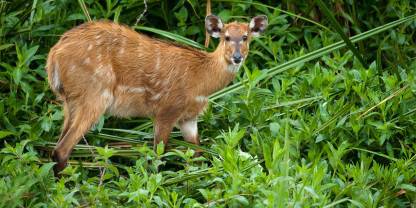Average Expert Rating
Rating Breakdown
Write a User ReviewKenya’s Smallest & Most Pedestrian-Friendly Park
This tiny and little-known park in western Kenya is unlikely to be of interest to mainstream tourists. But for more experienced wildlife enthusiasts, it offers the opportunity to see several exciting rarities. Foremost among these is the elusive sitatunga, a marsh-dwelling antelope that’s easily observed from one of several viewing platforms overlooking the swamp. Saiwa is also the best place in East Africa to look for the ultra-localised de Brazza’s monkey, which I’ve seen on two previous visits (a troop often visits the campsite in the late afternoon). The birding is a treat: likely highlights include grey crowned crane, black sparrowhawk, broad-billed roller, blue-headed coucal, double-toothed barbet, the stunning Ross’s turaco, and two real rarities in the form of yellow-billed barbet and grey-winged robin-chat. As a bonus, you might go an entire day here without seeing another tourist on the network of walking trails. A low-key gem!
Birds and Swimming Antelope
It’s a small patch of swamp with a thin border of jungly trees, and the only way to explore it is on foot
Read more
– a rare delight. The only large mammals you will see are sitatunga, a type of semi-aquatic antelope, and this is probably the best national park in all of East Africa in which to see them. There are also plenty of monkeys, with the flowing locks of the black-and-white colobus being the most memorable. With luck you might also catch a glimpse of Cape clawless or spotted-necked otter. But it’s birds where Saiwa really excels. More than 370 species have been seen in this tiny park including some that are more commonly associated with the jungles of the Congo or Uganda. I’m no expert birdwatcher but even I get excited about each flash of colour in the forest here, and to help the non-experts like me, highly knowledgeable ornithological guides are available at the park entrance. It pays to take one.A Short Wetland Nature Walk With the Possibility of Seeing an Unusual Antelope
Kenya’s smallest national park, this is best known as a refuge for the rare semi-aquatic sitatunga antelope, which unusually has splayed hooves, allowing it to walk on the swamp vegetation. We didn’t witness this display of bravery, but we did see a couple gracefully sliding through the water with their heads raised and nostrils flaring. Additionally, black-and-white colobus monkeys were fairly common in the wild fig trees, and several varieties of kingfisher fluttered around the bulrushes. The short walk through this tiny park (only three square kilometres) was easy along raised boardwalks, but it’s out of the way to get to and the sitatunga remains elusive most of the time as it rests semi-submerged and is very well hidden during the heat of the day. It’s best described as a nature walk to enjoy the birds and butterflies.
Sitatunga Antelopes and De Brazza’s Monkeys
If you come here early in the morning or late afternoon sitatunga sightings are almost guaranteed. Several viewing decks are well positioned to give you a good vantage point over the marsh. On my last visit I spent the night on one of these platforms, which had been converted to a cabin. Staying overnight elevates the whole experience to a different level. After dark I listened to a chorus of frogs and the screeching of rock hyrax all around me. The

